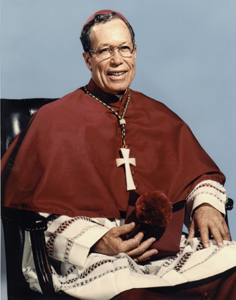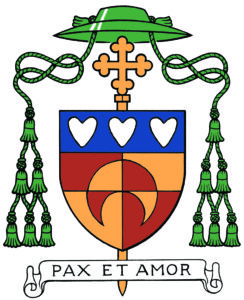Former Auxiliary Bishops

Bishop Francisco González, S.F.
Bishop Francisco González, S.F. was born on May 22, 1939 in Arcos de Jalon (Soria), Spain. One of five children, he entered the Seminario Misional de la Sagrada Familia in Barcelona in 1951. He took his final vows in the Congregation of the Sons of the Holy Family in 1960.
He studied theology and received an M.A. in comparative international education from The Catholic University of America in Washington, DC in 1967. On May 1, 1964, he was ordained a priest for the Sons of the Holy Family by The Most Reverend John J. Russell in Richmond, VA.
A priest for almost fifty years, Bishop González has served as a teacher and chaplain in high schools and has held a number of parish assignments in the Archdiocese of Washington, New Mexico and Colorado. His religious community elected him on three occasions as a delegate to their General Chapters. He has also served as rector of Holy Family Seminary in Silver Spring, MD and was Vice Provincial Superior for the Sons of the Holy Family in the United States until December 28, 2001 when he was named a bishop by Pope John Paul II, the first member of the Sons of the Holy Family to receive such appointment. He was ordained as a bishop in Washington, DC on February 11, 2002.
Bishop González has served as the spiritual advisor to the Hispanic Charismatic Prayer Groups and the Cursillo Movement in the Archdiocese of Washington. From 1987-1989, he was the national chaplain for Cursillo. In 1992, he was named Coordinator of the Hispanic Family Life Office for the Archdiocese of Washington. He also has served as Interim Secretary for Parish Life and Worship. Since 1997, when Cardinal James A. Hickey, then-Archbishop of Washington, appointed him Episcopal Vicar for Hispanic Catholics, Bishop González has served as the primary liaison between the Archbishop of Washington and the region’s large Hispanic community. He was honored with The James Cardinal Hickey Award by the Spanish Catholic Center in 2012 for his dedication and service to the Washington area community. He has chaired the Immigration Task Force for the Maryland Catholic Conference.
Bishop González is an internationally recognized speaker, leading retreats in the United States, Brazil, Venezuela, Spain, Mexico and Colombia. He has been interviewed by local and national media outlets, and since 1993, has written a weekly award-winning column for El Pregonero newspaper.
Bishop González has a brother and sister who are in religious life in Spain.

Bishop Leonard J. Olivier, S.V.D.
Born in Lake Charles, Louisiana in 1923, Bishop Olivier was the fifth of eight children. He attended Sacred Heart of Jesus grade school in Lake Charles and then St. Augustine Seminary in Bay St. Louis, Mississippi and St. Mary’s Seminary in Techny, Illinois. He was ordained a Divine Word Missionary in Bay St. Louis in 1951.
From 1951 to 1973, he was assistant dean, then dean of seminarians and, finally, rector of the religious community. From 1974 to 1982, he was Secretary of Studies for all United States Divine Word seminaries and rector of the religious community at Divine Word Seminary in Epworth, Iowa.
St. Anthony’s parish in Lafayette, Louisiana was his first pastorate. In the last two years of that assignment, then-Father Olivier also was part-time Vicar for Black Catholics in the Diocese of Lafayette. He was named full time Vicar in 1986, a position he held until appointed Auxiliary Bishop of Washington by Pope John Paul II on November 7, 1988.
Ordained bishop on December 20, 1988, Bishop Olivier has served at different times as Regional Bishop of Deaneries in the District of Columbia, Prince George’s County and Southern Maryland. He is a Fourth Degree Knight of St. Peter Claver, a Knight of St. John and a Knight of Columbus.
He served as the convenor of the African American Catholic Bishops and as the Episcopal liaison for the National African American Catholic Youth Ministry Network, and has served on a number of committees for the United States Conference of Catholic Bishops.

Coat of Arms of Bishop Francisco González
Blazon:
Quarterly Gules and Or, a crescent reversed counterchanged, on a chief Azure three hearts Argent.
Significance:
The central charge on the shield is a reversed crescent, symbolic of the patron saint of Bishop González; it is borne on the Arms of the family of the Jesuit saint, Francis Xavier (1506-1551). The colors of the crescent have been counter colored with those of the surface of the shield to emphasize the Castilian ancestry of the Bishop. The Arms of Castile, Spain, and branches of the González family display red and gold (yellow) colors.
The blue “chief” or upper portion of the shield bears three silver (white) hearts to denote Bishop González is a member of the Sons of the Holy Family, founded in Spain in 1864 by Blessed Joseph Manyanet.
The insignia of this congregation has been modified to bring it within the canons of heraldic blazon. The silver (white) hearts complement the Bishop’s motto, PAX ET AMOR (Peace and Love); the hearts for love and the silver (white) for peace. The blue of the “chief” honors Our Lady of Lourdes, upon whose feast Bishop González received ordination in the episcopate at the hands of the Cardinal Archbishop of Washington.
Behind the Arms is placed a gold (yellow) processional cross and ensigning the whole achievement is a pontifical hat with its six tassels on each side, disposed in three rows, all in green. These are the heraldic insignia of a prelate of the rank of a bishop in accordance with the Instruction of the Holy See, dated 31 March, 1969. Before 1870, the pontifical hat was worn at solemn cavalcades held in conjunction with papal ceremonies. The color of the hat and the number tassels were signs of the rank of the prelate, a custom still preserved in ecclesiastical heraldry.
The Arms were devised by A.W.C. Phelps, Cleveland, Ohio in consultation with The Most Reverend Francisco González, S.F., D.D

Coat of Arms of Bishop Olivier
Blazon:
Azure, on a mount in base Or charged with a bar wavy Azure, a dove Argent, in its beak a branch of olive Vert fructed Or, on a chief per pale Gules and Or, in the dexter a terrestial globe surmounted on a cross coupled Argent, in the sinister a roundel of the last fimbrated Azure.
Motto:
“Lead Me, Guide Me” (Psalm 20, v. 4)
Significance:
The Arms of Bishop Olivier consist of a blue shield charged with a silver (white) dove standing on a gold (yellow) mount at the base of the shield. The dove has in its beak a green olive branch, and the mount is charged with a blue wavy bar.
The dove, symbol of the Holy Spirit, alludes to Bishop Olivier’s motto and honors the influence of the Holy Ghost Fathers in his life. The olive branch, symbol of peace and strength also sings, or cants, in an heraldic manner upon the family name, Olivier.
The blue wavy bar across the gold (yellow) mount recalls the Bayou region of Louisiana. In this area are the dioceses of Lafayette and Lake Charles where Bishop Olivier was born and has served as a priest. By a happy coincidence the Arms of these dioceses also display the combined colors of blue and gold (yellow).
The “chief,” or upper portion of the shield is divided in the center—red to the left of the viewer (dexter in heraldry) and gold (yellow) to the right of the viewer (sinister in heraldry). The red section is charged with he insignia, or emblem, of the Society of the Divine Word, a custom long established for members of religious orders who are raised to the episcopate. The Society displays a terrestial globe surmounted by a cross in silver (white) symbolic of its commitment to world evangelization to draw all to Christ. The gold (yellow) section is charged with a silver (white) disc edged in blue honoring the Eucharist, and commemorates the influence of the Sisters of the Blessed Sacrament in Bishop Olivier’s life; the colors of this sisterhood are blue and white.
Bishop Olivier’s motto, “Lead Me, Guide Me,” is taken from Psalm 30, verse 4; it expresses his prayer for wisdom, guidance and strength for himself and for all those committed to his care.
Behind the Arms is placed a gold processional cross and ensigning the whole achievement is a pontifical hat with its six tassels on each side, disposed in three rows, all in green. These are the heraldic insignia of a prelate of the rank of bishop in accordance with the Instruction of the Holy See, dated 31 March 1969. Before 1870, the pontifical hat was worn at solemn cavalcades held in conjunction with papal ceremonies. The color of the hat and the number of tassels were signs of the rank of the prelate, a custom still preserved in ecclesiastical heraldry.
These Arms were devised November 16-17, 1988 by A.W.C. Phelps (member of The Heraldry Society, London, England), Cleveland, Ohio, in cooperation with The Most Reverend Leonard J. Olivier, SVD, DD.
